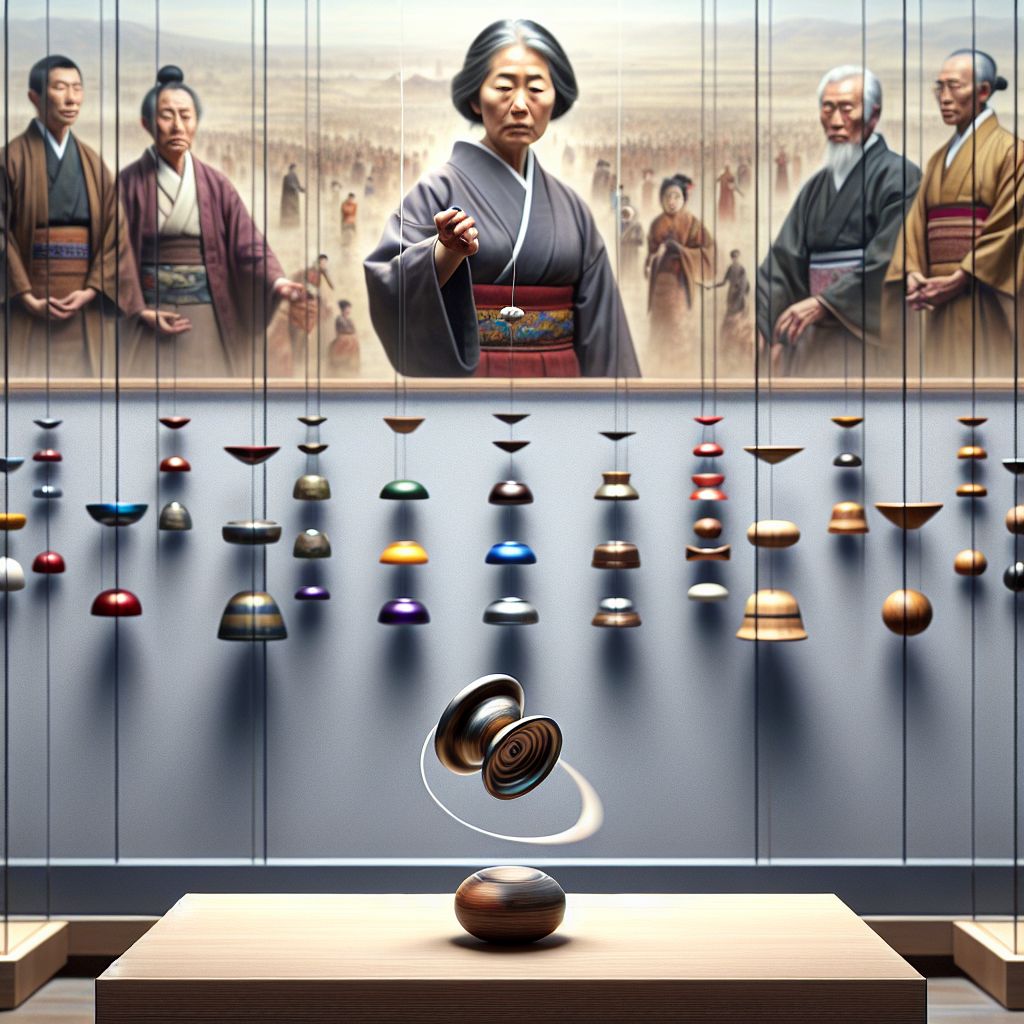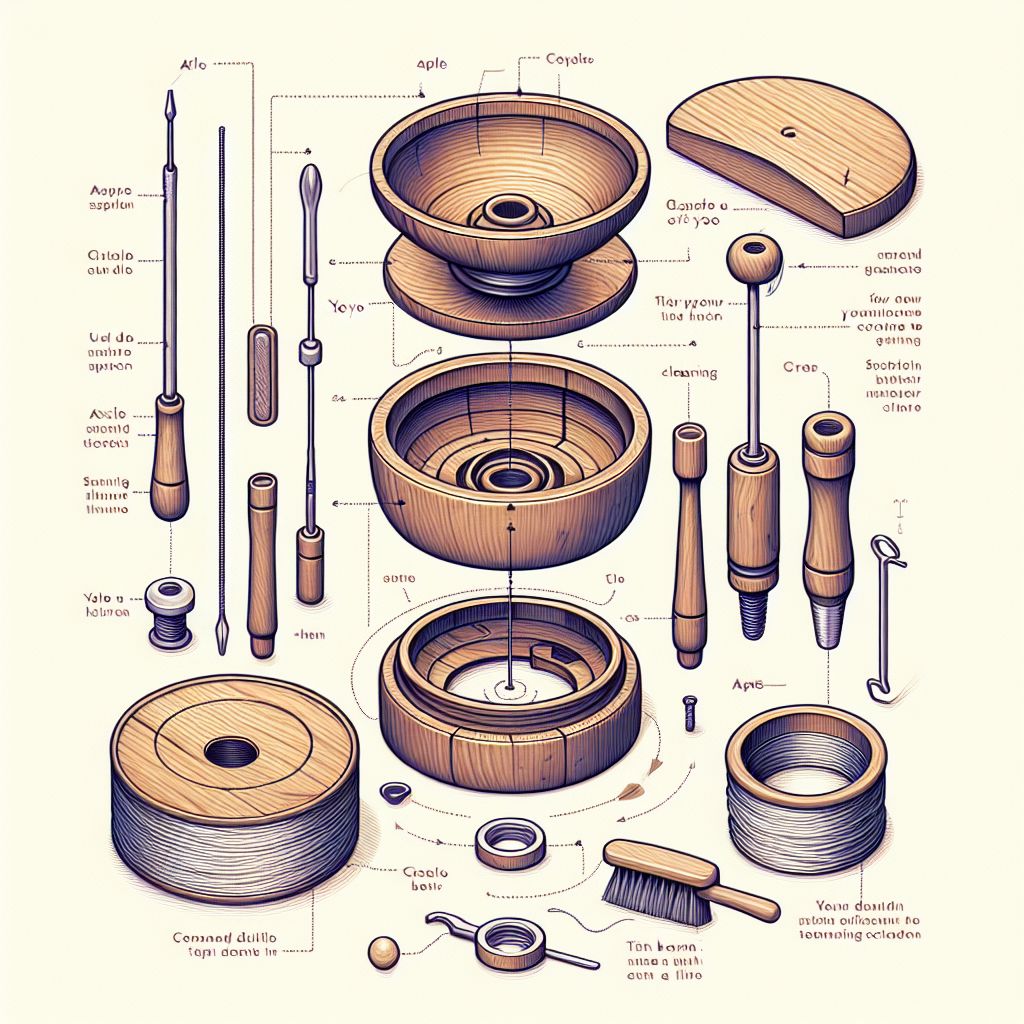- Introduction to Advanced Yoyoing
- Essential Yoyo Equipment for Advanced Techniques
- Fundamentals of Advanced Yoyo Techniques
- Mastering Advanced Yoyo Tricks
- Combining Tricks into Routines
- Yoyo Maintenance and Upkeep
- Advanced Yoyoing Practice Techniques
- Yoyo Competitions and Community
- Inspirational Yoyo Performers and Resources
- Conclusion: The Journey of Yoyo Mastery
Introduction to Advanced Yoyoing

The humble origins of the yoyo can be traced back over two millennia, with historical artifacts suggesting its use as early as 500 BCE in Greece. However, the yoyo as we know it gained popularity in the 20th century as a children's toy. From these simple beginnings, the yoyo has undergone a remarkable evolution, transforming into a sophisticated instrument capable of an array of complex tricks and performances.
The journey from basic yoyoing to mastering advanced techniques is one marked by significant dedication and practice. The art of yoyoing transcended its initial phase with the introduction of the responsive yoyo, which returns to the hand with a mere tug of the string. In time, enthusiasts sought to push the boundaries further, leading to the development of unresponsive yoyos that require a 'bind' to return, thereby unlocking a new realm of trick possibilities.
Advanced yoyoing is characterized by intricate string tricks, off-axis play (also known as "offstring"), and looping maneuvers that demand a high level of precision and control. As yoyo players, or 'throwers', strive for excellence, they engage in continuous practice and often look to the community and competitive scenes for inspiration and skill development.
Today, the art of yoyoing is not only a pastime but also a competitive sport with a global following. Professional throwers exhibit a blend of creativity, agility, and technical skill, showcasing just how far this dynamic skill toy has come. To master the advanced techniques of yoyoing, one must embark on a journey of persistent practice, learning, and refinement.
Essential Yoyo Equipment for Advanced Techniques

Choosing the right yoyo is paramount for anyone looking to perform advanced tricks. The type of yoyo, its string, weight distribution, and any potential modifications can have a profound impact on a player's ability to execute complex maneuvers.
- Responsive vs. Unresponsive Yoyos
- Responsive yoyos are designed to return to the player's hand with a simple tug on the string, making them well-suited for beginners. However, advanced yoyoing usually requires an unresponsive yoyo, which doesn't return unless a 'bind' trick is performed. This feature allows for extended trick combinations since the yoyo will stay at the end of the string until the player commands it to return.
- String Types
- The string is a critical component in yoyoing. Most advanced players prefer a polyester or a blend of polyester and cotton, as these materials provide a good balance between responsiveness and durability. The string's thickness can also affect play, with thicker strings being more suitable for complicated string tricks due to their ability to hold tension better.
- Weight Distribution
- Advanced yoyo designs often emphasize a specific weight distribution to facilitate longer spin times and stability during tricks. Yoyos with weight focused on the rims, known as rim-weighted, are particularly sought after for their inertia, which is beneficial for executing long series of tricks. Conversely, center-weighted yoyos offer quicker movement and are often preferred for speed combos.
- Modifications
- To enhance performance, players may also modify their yoyos. This can include changing the bearing for one that provides smoother spins or less friction. Some players also experiment with different response systems, such as silicone pads or flowable silicone, to customize the level of grip the yoyo has on the string during binds.
Ultimately, the choice of equipment is a deeply personal aspect of yoyoing, and what works for one player may not work for another. Advanced players will often have a collection of yoyos and accessories to choose from, allowing them to adapt their setup to suit a specific style of play or trick category. Mastery over advanced yoyo techniques begins with understanding and selecting the right equipment, followed by continuous practice and fine-tuning of one's gear.
Fundamentals of Advanced Yoyo Techniques

Mastering advanced yoyo techniques rests on a foundation of several core principles. Each element plays a crucial role in the execution of complex tricks and combinations.
- String Tension Control
- Proper string tension is essential for executing tricks accurately. Too much or too little tension can result in twists and loss of control. Players should regularly check and adjust their string tension, using techniques such as "UFO" or "sidewinders" to unwind or wind the string accordingly.
- Throw Precision
- A precise throw sets the stage for every trick. The yoyo must be released with a smooth, controlled motion to ensure a straight spin. Beginners can improve their throw precision by practicing a straight sleeper, aiming to keep the yoyo spinning in place without wobbling or tilting.
- Hand-Eye Coordination
- Advanced yoyoing requires excellent hand-eye coordination to manage the yoyo and string simultaneously. To enhance this skill, throwers can practice juggling the yoyo between their hands, focusing on the fluidity of movements and maintaining visual contact with the yoyo at all times.
To improve these fundamental skills, here are some tips:
- Practice Consistently: Like any skill, consistent practice is the key to improvement. Set aside regular time to work on each aspect of your yoyoing technique.
- Focus on Basics: Before attempting advanced tricks, ensure that you have mastered the basics. A solid foundation makes it easier to progress to more complicated maneuvers.
- Record and Review: Use a camera to record your practice sessions. Watching yourself can highlight areas that need improvement that you might not notice in the moment.
- Use Slow Motion: Analyzing tricks in slow motion can help understand the intricacies of string movements and hand positioning.
- Seek Feedback: Engage with the yoyo community for feedback. Experienced players can provide valuable insights into refining your techniques.
- Stay Relaxed: Maintaining a relaxed grip and posture helps in executing smooth and fluid tricks. Tension can lead to erratic movements and loss of control.
By focusing on these fundamentals and incorporating the tips for improvement, players will establish a robust platform from which they can explore the vast landscape of advanced yoyo tricks and techniques.
Mastering Advanced Yoyo Tricks

Advanced yoyo tricks often involve intricate movements and precise timing. Below are step-by-step guides for several advanced tricks, including 'Spirit Bomb,' 'Ladder Escape,' and 'Rancid Milk.' Each trick is challenging in its own right, but with patience and practice, they can be mastered.
Spirit Bomb
- Start with a 'Split Bottom Mount.' Swing the yoyo over your non-throw hand pointer finger and land it on the string.
- Pop the yoyo up into the air slightly and cross your hands, passing the yoyo through the triangle of string that forms.
- Uncross your hands and pop the yoyo up again, this time landing it on the two strings farthest from you.
- Drop the string off your non-throw hand pointer, creating a new triangle. Swing the yoyo through this triangle.
- Perform another pop, but this time land the yoyo on the single string closest to you.
- Finally, pop the yoyo up and out of the formation and bind to return the yoyo to your hand.
Common challenges include missing the string segments during pops and not having enough slack for the yoyo to pass through triangles. Ensure that each pop is controlled and that you give enough slack for the yoyo to move smoothly through the trick's steps.
Ladder Escape
- Begin with a 'Houdini Mount.' Perform a 'double on' trapeze, and then cross your arms to make a 'bucket.'
- Drop the yoyo through the bucket and land on the back string, then execute a 'Green Triangle' formation.
- Roll the yoyo out to the left and perform a 'brother slack' to create a 'ladder' formation.
- Navigate the yoyo through the 'ladder' by popping it up through each successive opening until you reach the top.
- Once at the top, dismount to the right and bind to return the yoyo to your hand.
Challenges with 'Ladder Escape' often stem from difficulty in creating and managing the 'ladder' formation. Practice each step of the trick separately to ensure that your transitions are smooth and accurate.
Rancid Milk
- Start with a 'Trapeze' and then perform a 'Mach 5 Mount' by bringing your non-throw hand under the yoyo and then over it, creating several layers of string around the yoyo.
- Begin a series of intricate string rejections and pops, manipulating the layers of string around the yoyo to form different shapes and mounts.
- Work through the sequence of string manipulations, ensuring that the yoyo lands on the correct string segment each time.
- Conclude the trick with a dismount and a bind to return the yoyo to your hand.
The complexity of 'Rancid Milk' lies in the sequence of string manipulations and landings. A common challenge is maintaining the tension and orientation of the string layers. Focus on keeping your hands aligned and the string segments separated to avoid tangles.
For all these tricks, overcoming challenges often comes down to breaking down the trick into its core components and practicing each segment individually. Smooth execution comes from muscle memory and understanding the flow of the trick. Don't rush through the steps; instead, take your time to learn the nuances and transitions. As with any advanced skill, perseverance is key. Keep practicing, and don't be discouraged by mistakes—they're an inevitable and valuable part of the learning process.
Combining Tricks into Routines

Combining individual yoyo tricks into a flowing routine is where style and creativity come to the forefront in yoyoing. A well-constructed routine not only demonstrates technical skill but also the thrower's ability to create an engaging performance. Here are key elements to consider when linking tricks into a routine:
- Transitions
- Smooth transitions between tricks are essential. They can be as simple as a 'bind' or as complex as a 'slack' or 'whip' that moves seamlessly into the next trick. A good transition feels natural and maintains the momentum of the performance.
- Timing
- Timing is critical in a routine. It's important to match the pace of your tricks with the rhythm of the music (if used) and to ensure that each trick is given enough time to be showcased without rushing.
- Performance Flair
- Add your unique touch to the routine with elements of performance flair. This could include dramatic pauses, changes in speed, or even choreography that involves body movements beyond just the hands.
To create a routine, consider the following structure:
- Opening: Start with a strong, attention-grabbing trick or sequence to set the tone.
- Build-Up: Move into a series of tricks that gradually increase in complexity and build momentum.
- Climax: Include the most impressive or difficult trick at the peak of your routine to wow the audience.
- Conclusion: End with a trick that has a decisive finish, allowing for a clean and emphatic bind to signal the end of the routine.
An example routine could begin with a 'Trapeze' into a 'Double or Nothing', followed by a smooth transition into a 'Houdini Mount' and then a 'Spirit Bomb'. The climax might feature a fast-paced series of 'Eli Hops' before concluding with a dramatic 'Gyroscopic Flop' and final bind.
To practice creating routines, start by writing down a list of tricks you are comfortable performing. Experiment with different orders and transitions, and practice the flow until it feels natural. Remember, a routine is more than just a string of tricks; it's a performance that tells a story. Consider your audience and what you want them to feel or remember about your routine. With time and practice, you'll develop a sense of how to craft routines that are not only technically impressive but also entertaining and memorable.
Yoyo Maintenance and Upkeep

Maintaining a yoyo in top condition is crucial for ensuring peak performance and prolonging the lifespan of the yoyo. Here are some key maintenance tips:
- Cleaning
- To clean the yoyo, first disassemble it carefully. Wipe down the body with a soft cloth to remove any dust or grime. If there's stubborn dirt, use a small amount of rubbing alcohol on the cloth. Be cautious with the bearing seat and response system to avoid damage.
- Lubricating Bearings
- Bearings require regular lubrication to spin smoothly and quietly. Use a thin yoyo lubricant by applying a small drop directly onto the bearing. Do not over-lubricate, as this can attract dirt and actually slow down the bearing. For unresponsive play, use an even smaller amount to maintain a low level of friction.
- Replacing Strings
- Strings wear out with use and should be replaced regularly. Fraying, loss of tension, or discoloration are signs that it's time for a new string. Always have spare strings on hand and learn to tie the proper loop at the end of the string for a secure attachment to your finger.
Proper maintenance can greatly improve a yoyo's performance:
- Longer Spin Times: Clean, lubricated bearings can spin freely, resulting in longer spin times and smoother play.
- Consistent Response: A clean response system ensures that the yoyo returns to your hand reliably when you perform a bind.
- Optimal String Play: Fresh strings provide the right amount of tension and flexibility for executing tricks accurately.
It's also wise to periodically check the yoyo for any damage, such as cracks or dents, which could affect performance or safety. If you're using a yoyo with an adjustable gap, make sure it's set to your preference and that the yoyo halves are screwed together securely but not overtightened.
By taking the time to maintain your yoyo, you'll not only enjoy a better playing experience but also invest in the longevity of your equipment. Remember, a well-maintained yoyo is a reliable partner in the journey towards mastering advanced yoyoing techniques.
Advanced Yoyoing Practice Techniques

Efficient practice is the cornerstone of mastering any advanced skill, including yoyoing. Here are some methods to ensure that practice sessions are as effective as possible:
- Setting Goals
- Begin each practice session with clear, achievable goals. Whether it's perfecting a specific trick or working on a transition, having a focus will guide your practice and provide a sense of accomplishment.
- Recording Performances
- Using a camera to record practice sessions can be incredibly beneficial. It allows you to review your technique and pinpoint areas that need improvement. Additionally, watching yourself succeed can be a motivational tool.
- Incremental Learning
- Break down complex tricks into smaller, manageable parts. Master each part individually before attempting the entire trick. This step-by-step approach helps to build muscle memory and reduces frustration.
Here are additional tips to maximize the effectiveness of practice sessions:
- Consistent Practice: Dedicate time every day to practice. Consistency is key to progress, especially when working on advanced techniques.
- Quality Over Quantity: It is better to have a shorter session of focused, high-quality practice than to practice for hours without focus.
- Stay Patient: Advanced tricks can be complex and may take time to learn. Be patient with yourself and celebrate the small victories along the way.
- Use Slow Motion: Watching tricks performed in slow motion can help you understand the intricacies and timing required, which you can then replicate during practice.
- Seek Feedback: Don't hesitate to ask for feedback from the yoyo community. Experienced players can offer valuable insights and encouragement.
- Stay Inspired: Watching performances by seasoned yoyo players can provide inspiration and new ideas for your own routines.
Consistent practice is not just about repetition; it's about mindful repetition with the intent to improve. By incorporating these practice techniques, you'll be well on your way to mastering advanced yoyo tricks and developing a style that is uniquely your own. Remember, the journey to becoming an advanced yoyo player is a marathon, not a sprint, and every practice session is a step towards achieving mastery.
Yoyo Competitions and Community

The yoyo community is a vibrant and welcoming space, with enthusiasts ranging from hobbyists to professional competitors. Yoyo competitions provide an avenue for throwers to showcase their skills, connect with others, and push the limits of what can be achieved with a yoyo.
To get involved in the yoyo community and competitions, consider the following steps:
- Online Forums and Social Media: Platforms such as Reddit, Facebook groups, and Instagram are great places to connect with other yoyo players. They can provide information on events, share tips, and offer support.
- Local Yoyo Clubs and Meetups: Joining a local yoyo club or attending meetups can provide hands-on experience and the opportunity to learn from others in person.
- Regional and National Competitions: Attending larger competitions as a spectator or competitor can give you a sense of the competitive scene and inspire your own practice.
At yoyo competitions, you can expect to see a variety of events, such as:
- 1A (Single Hand String Trick): This is the most common division, where players perform tricks with one yoyo and one string.
- 2A (Two-Handed Looping): Competitors use two responsive yoyos, one in each hand, doing looping tricks.
- 3A (Two-Handed String Trick): Players use two unresponsive yoyos and perform string tricks with both simultaneously.
- 4A (Offstring): The yoyo is not attached to the string, allowing for a different set of airborne tricks.
- 5A (Counterweight): A counterweight is attached to the end of the string instead of your finger, enabling a different style of play.
Joining a yoyo community can offer numerous benefits, such as:
- Learning and Growth: The exchange of knowledge and techniques can accelerate your learning curve and inspire creativity.
- Motivation: Being part of a community can provide motivation to keep practicing and improving, especially when you see the accomplishments of your peers.
- Friendship: Yoyoing can be a solitary activity, but the community aspect introduces friendship and camaraderie, making it a social hobby as well.
- Networking: Making connections within the community can lead to opportunities such as sponsorships, collaborations, and professional growth.
Whether you're looking to compete at the highest level or simply share your passion with like-minded individuals, the yoyo community is a supportive and enriching environment. As you delve into the world of yoyos, remember that community is one of the most valuable resources available to you on your journey.
Inspirational Yoyo Performers and Resources

Several yoyo players have left their mark on the community through their skill and creativity. These individuals often serve as a source of inspiration for those looking to master advanced yoyo techniques.
Famous yoyo performers include:
- Hiroyuki Suzuki: Also known as "Mickey," Suzuki is a multiple-time world champion known for his incredibly fast play and precise technique.
- Gentry Stein: Stein has won numerous national and world titles and is admired for his smooth style and innovative trick composition.
- Shu Takada: Renowned for his performances in the 2A division, Takada combines yoyoing with acrobatics and dance, bringing a unique flair to the sport.
- Takeshi Matsuura: Matsuura is a multi-division competitor who has won world championships in both 5A and 3A, showcasing his versatility.
- Evan Nagao: Known for his artistic and expressive performances, Nagao has claimed top honors at national and world competitions.
For inspiration and learning, here are some valuable resources:
- Online Tutorials
- YouTube channels like YoTricks, YoYoExpertTutorials, and Dylan Kowalski offer extensive libraries of tutorials ranging from beginner to advanced levels.
- Forums
- The YoYoExpert forums and the r/Throwers subreddit are hubs where players can seek advice, share experiences, and discuss the latest in yoyoing.
- Social Media Accounts
- Following professional yoyoers on Instagram and Twitter can provide daily doses of inspiration. Look for accounts like @GentryStein, @Hiroyuki_Suzuki, and @Shu_Takada, where they share clips of new tricks and performances.
- Manufacturer Content
- Yoyo manufacturers also produce tutorials and showcase their team riders. Brands like YoYoFactory, CLYW (Caribou Lodge Yoyo Works), and Duncan have active online presences.
By engaging with these resources, you can witness the pinnacle of yoyo performance and learn from the best in the field. Whether you're just starting out or are well on your way to becoming an advanced player, the wealth of available content can guide your practice and fuel your passion for yoyoing.
Conclusion: The Journey of Yoyo Mastery

The journey to yoyo mastery is one of continuous learning, exploration, and personal expression. As you delve into the art of yoyoing, remember that every thrower's path is unique, and the true joy lies in the process as much as in the results. Whether you're perfecting a new trick, developing a routine, or simply enjoying the fluid motion of the yoyo, each step forward is a testament to your dedication and passion for this timeless skill toy.
Practice, while essential, is just one facet of the yoyoing experience. Engaging with the community, sharing your progress, and learning from others are all integral to the journey. As you advance in your skills, take time to reflect on your progress and the goals you've achieved, and set new challenges to keep your practice fresh and exciting.
Remember, yoyoing is not only about competition and technical prowess; it is also an art form that allows for self-expression. The creativity and style you bring to your yoyo play are what make your performance unique. So, keep an open mind, experiment with different techniques, and above all, have fun with it. The journey of yoyo mastery is ongoing, and each throw is an opportunity to discover something new about the yoyo, and about yourself.


